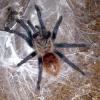Hello,
Nuptial flights are starting and some are heading out to hunt for queens. I decided to gather a list of dangerous wildlife you may encounter and what safety steps to take. These are Southern California dangers, feel free to add on animals from your areas as well.
Mountain Lion: https://www.nps.gov/...ture/cougar.htm
If you encounter a lion, remember the goals are to convince it that you are not prey and that you may be dangerous. Follow these safety tips:
- Do not approach a lion. Most mountain lions will try to avoid a confrontation. Give them a way to escape.
- Do not run from a lion. Running may stimulate a mountain lion's instinct to chase. Instead, stand and face the animal. Make eye contact. If you have small children with you, pick them up if possible so that they don't panic and run. Although it may be awkward, pick them up without bending over or turning away from the mountain lion.
- Do not crouch down or bend over. A human standing up is just not the right shape for a lion's prey. Conversely, a person squatting or bending over resembles a four-legged prey animal. In mountain lion country, avoid squatting, crouching or bending over, even when picking up children.
- Do all you can to appear larger. Raise your arms. Open your jacket if you are wearing one. Again, pick up small children. Throw stones, branches, or whatever you can reach without crouching or turning your back. Wave your arms slowly and speak firmly in a loud voice. The idea is to convince the mountain lion that you are not prey and that you may be a danger to it.
- Fight back if attacked. A hiker in southern California used a rock to fend off a mountain lion that was attacking his son. Others have fought back successfully with sticks, caps, jackets, garden tools and their bare hands. Since a mountain lion usually tries to bite the head or neck, try to remain standing and face the attacking animal.
Rattlesnake: https://www.ucdmc.uc...nake-bites.html
Rattlesnake bites can produce extreme pain and swelling at the location of the bite, excessive bleeding,nausea, swelling in the mouth and throat making it difficult to breathe, lightheadedness, drooling, and even collapse and shock in rare cases.
If bitten by a rattlesnake:- Get immediate medical attention, as severe or even life-threatening symptoms may occur within minutes after the bite, or in other cases may begin after couple of hours.
- Do not apply ice, do not use a tourniquet or constricting band, do not try to suck out the venom, and do not use any device to cut or slice the bite site.
- Constricting blood vessels near a rattlesnake bite can lead to amputation. Wash the wound with soap and water, and remove wristwatches, rings or anything constrictive
- Keep calm, do not run and keep the affected extremity below heart level until you can be transported to a medical facility
Bear attacks are rare; most bears are only interested in protecting food, cubs, or their space. However, being mentally prepared can help you have the most effective reaction. Every situation is different, but below are guidelines on how brown bear attacks can differ from black bear attacks. Help protect others by reporting all bear incidents to a park ranger immediately. Above all, keep your distance from bears!
- Brown/Grizzly Bears: If you are attacked by a brown/grizzly bear, leave your pack on and PLAY DEAD. Lay flat on your stomach with your hands clasped behind your neck. Spread your legs to make it harder for the bear to turn you over. Remain still until the bear leaves the area. Fighting back usually increases the intensity of such attacks. However, if the attack persists, fight back vigorously. Use whatever you have at hand to hit the bear in the face.
- Black Bears: If you are attacked by a black bear, DO NOT PLAY DEAD. Try to escape to a secure place such as a car or building. If escape is not possible, try to fight back using any object available. Concentrate your kicks and blows on the bear's face and muzzle.





















